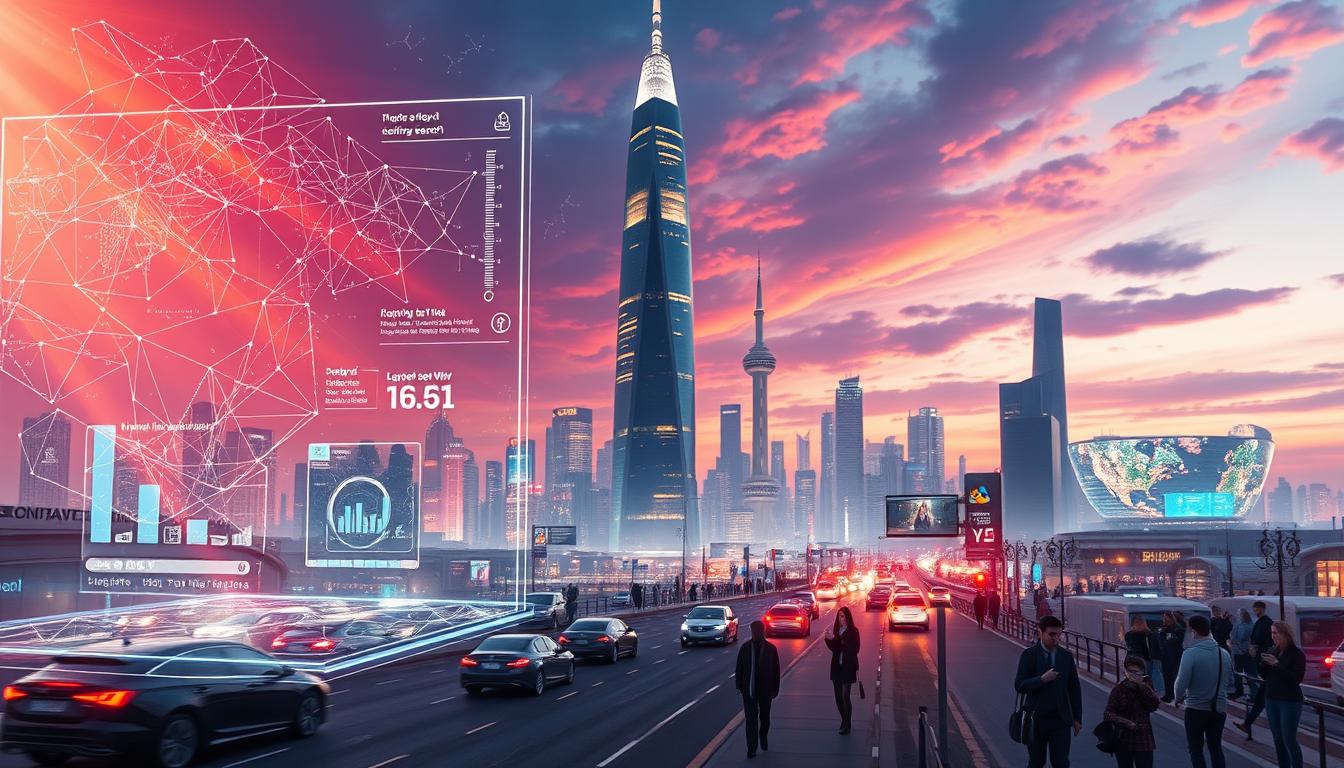Exploring AI in search means diving into the basics and their effects on our online lives. The change in search engine algorithms is huge, thanks to machine learning in search.
This change has reshaped how we find information online. It’s key to understand this tech.
Key Takeaways
- Knowing how AI works in search engines is key for finding online info.
- Machine learning boosts search engine algorithms a lot.
- AI has greatly changed search engines.
- AI in search makes search results more relevant.
- The future of search engines will keep being shaped by AI.
The Evolution of Search Engines
Search engines have come a long way from their simple start to today’s AI-driven systems. This change has greatly affected how we find information online.
From Simple Algorithms to Complex AI Systems
At first, search engines used basic algorithms to list web pages by keyword. But as the web expanded, these algorithms got smarter. Now, they use advanced AI to grasp context, intent, and even guess what users might want.
Key Milestones in Search Engine Development
There have been a few big moments in search engine history. Two major ones are the creation of PageRank and the move to semantic search.
The Birth of PageRank
Google’s PageRank changed the game by ranking pages by their importance. This was based on the number and quality of links to them. It made search results much more relevant.
The Shift to Semantic Search
Another big step was the switch to semantic search. This method understands the meaning and context behind search queries. It gives users more tailored and useful results.
Understanding AI and Machine Learning Basics
To understand AI’s role in search, we must first learn the basics of AI and machine learning. AI creates systems that can do tasks that need human smarts.
Core AI Concepts for Search
Machine learning is a part of AI that makes algorithms learn from data on their own. There are a few main ideas to get:
Supervised vs. Unsupervised Learning
Supervised learning uses labeled data to train algorithms. Unsupervised learning works with data without labels, finding patterns and connections.
How Machine Learning Enhances Search Capabilities
Machine learning boosts search abilities, mainly by recognizing patterns in what users search for. This helps search engines get what you’re looking for better.
- Improved relevance of search results
- Enhanced ability to handle complex queries
- Better personalization based on user behavior
How AI Powers Modern Search Engines
AI is key to modern search engines, making them smarter at handling complex searches. This change comes from big steps in natural language processing (NLP) and neural networks.
Natural Language Processing in Search
NLP is vital for search engines to get what we mean. It looks at the context and meaning of our searches. This way, search engines give us better results.
Understanding User Intent
NLP helps search engines figure out what we really want. It looks at the search’s context, syntax, and meaning. This helps give us results that match our needs.
Neural Networks and Deep Learning Applications
Neural networks and deep learning are also key. They help search engines learn from us and get better over time.
How Search Engines Learn from User Behavior
Search engines get smarter by watching how we use them. They look at what we click and how we search. This learning is thanks to neural networks and deep learning, making them more user-friendly.
AI Overview in Search Engine Results
Understanding AI’s role in search engine results is key for better online content. AI plays a big part in how search results are ranked and relevant. This greatly affects how users find what they need online.

How AI Determines Relevance and Ranking
AI looks at several things to figure out if a webpage is relevant. It checks content quality, keyword usage, and user engagement. This helps AI rank webpages better, so users get the best results for their searches.
- Content quality assessment
- Keyword usage analysis
- User engagement metrics
The Impact of AI on Search Result Quality
AI has made search results much better. AI search engines understand search queries better, giving more accurate results. This leads to higher user satisfaction and more precise information.
Measuring Search Satisfaction
It’s important to measure how happy users are with search results. Key metrics include:
- Click-through rates
- Time spent on result pages
- User feedback mechanisms
By looking at these metrics, search engines can make their AI better. This improves search results and user experience.
Google’s AI Search Technologies
AI has changed how Google finds information, making searches better and more relevant. This is thanks to several AI technologies Google has created. These technologies are key to Google’s search engine.
RankBrain and BERT Explained
Google’s AI search is boosted by RankBrain and BERT. RankBrain was introduced in 2015. It helps Google understand the meaning behind search queries.
How These Systems Interpret Queries
BERT, or Bidirectional Encoder Representations from Transformers, took it a step further. It looks at the fine details of language, like word relationships. This lets Google give more precise answers by getting the intent and context of searches.
MUM and Other Recent AI Advancements
Google keeps pushing the limits with AI, introducing MUM (Multitask Unified Model). MUM is a big step up, able to handle information in many languages and formats.
Multimodal Understanding in Search
MUM’s main feature is multimodal understanding. It can work with text, images, and more. This makes searching easier and more flexible for users.
- MUM can handle complex queries with many parts.
- It makes search results more complete.
- MUM’s ability to work with different types of data is a big deal for future search tech.
Voice Search and Conversational AI
Conversational AI is key to voice search, making interactions more natural. Voice assistants are now a big part of our lives. It’s important to know how they work.
How AI Powers Voice Assistants
Voice assistants like Siri, Alexa, and Google Assistant use AI to get voice commands. Natural Language Processing (NLP) helps them understand human language. This includes context, idioms, and slang.
AI looks at lots of data to get better at recognizing voices. This makes voice assistants more accurate over time.
Optimizing for Voice Search in the AI Era
Optimizing for voice search is different from traditional SEO. Voice searches are longer and more like conversations. Using long-tail keywords and natural language is key.
Differences Between Text and Voice Queries
Voice queries are more conversational and often ask questions. For example, “weather New York” is a text search. But “What’s the weather like in New York today?” is a voice query.
- Voice queries are often longer and more specific.
- They tend to be in the form of questions.
- Context and location matter a lot in voice search results.
By understanding these differences, businesses can do better in voice search results.
Visual Search and AI Image Recognition
AI is getting better at visual search, making image searches more accurate. This change is making search engines easier to use and more visual.
Interpreting Images for Search
AI image recognition is key to visual search. It lets search engines understand what’s in images. This tech uses advanced algorithms to spot objects, scenes, and activities in pictures, giving better search results.
Key aspects of AI image recognition include:
- Object detection: Finding specific objects in an image.
- Scene understanding: Knowing the context or setting of an image.
- Activity recognition: Spotting actions or activities in an image.
Applications and Future of Visual Search
Visual search is used in many fields, like e-commerce, healthcare, and education. For example, users can find similar items online by uploading images.
Lens Technology and Shopping Applications
Google Lens is a great example of visual search. It lets users search by image. It can find products, landmarks, and text in images, giving relevant results.
The future of visual search is exciting, with possible improvements in:
- Improved accuracy: Making image recognition even better.
- Increased adoption: Visual search will be used more widely.
- New applications: Finding new ways to use visual search.
As visual search gets better, it will play a big role in our digital lives. It will make finding information easier and search more intuitive.
Personalization: How AI Tailors Search Results
AI is changing how search engines work, making results more personal. This change comes from better user behavior analysis and prediction. Now, search engines can really get to know what users like.
User Behavior Analysis and Prediction
AI looks at lots of user data, like what you’ve searched for and where you are. This helps search engines personalize your results. You get information that’s more likely to be what you want to see.
Balancing Personalization with Privacy
Personalized results are great, but they also make us worry about privacy. It’s a trade-off between getting what you want and keeping your data safe. Search engines have to find a way to keep users’ trust.
Filter Bubbles and Their Implications
Personalization can lead to “filter bubbles,” where you only see certain views. This can make you more likely to agree with what you already think. It’s important for everyone to understand this to keep the internet diverse and open.

AI-Powered SEO: Adapting to the New Reality
AI is changing how we search online. SEO strategies need to keep up. We must adjust how we optimize content and our websites’ technical aspects for AI.
Content Optimization for AI Search Algorithms
AI search engines look for content that shows expertise, authority, and trustworthiness (E-E-A-T). To meet these standards, create high-quality, relevant content.
E-E-A-T and Content Quality Signals
E-E-A-T is Google’s way to check content quality. To boost E-E-A-T, make sure your content is:
- Well-researched and accurate
- Created by experts or those with relevant experience
- Trustworthy and free from misinformation
By focusing on these, you can make your content more visible in AI search results.
Technical SEO Considerations in the Age of AI
Technical SEO is just as important with AI. One key thing is using structured data to help search engines understand your content.
Structured Data and Entity Optimization
Adding structured data markup to your website can help AI algorithms understand your content better. Also, optimizing entities on your site can make it more relevant and authoritative.
By combining content optimization with technical SEO, you can boost your website’s performance in AI search results.
Ethical Considerations and Biases in AI Search
AI is changing how we search, but it raises big ethical questions. The use of AI in search engines worries people about bias, transparency, and who’s accountable.
Identifying and Addressing Algorithmic Bias
Algorithmic bias means AI results can be unfair or discriminatory. This happens when AI is trained on biased data or has flawed algorithms. To fix this, we need to find and fix the bias sources. Data checks and special algorithms can help make AI search fairer.
Transparency and Accountability in AI Search Systems
It’s important for AI search systems to be clear about how they work. Accountability mechanisms are key to fixing problems. This means explaining AI choices and having ways to appeal or correct results.
The Role of Human Oversight
Having humans check AI decisions is key to ethical AI search. It stops biases and makes sure results are right and fair. This oversight also helps improve AI algorithms by giving feedback for better performance.
The Future of AI in Search
The future of AI in search is set to change how we find information. New technologies will shape the search world.
Emerging Technologies and Trends
Quantum computing is a big deal. It can process complex searches fast.
Quantum Computing and Search
Quantum computing could make search engines faster and more accurate. It’s early, but its impact will be big.
Predictions for the Next Decade
In the next decade, search and ambient computing will merge. This means search will fit into our lives more smoothly.
The Convergence of Search and Ambient Computing
We’ll see more voice searches and AI info delivery. This will make finding info easy and effortless.
Leveraging AI Search Knowledge in Your Digital Journey
Understanding AI in search is key for anyone online. Knowing how AI powers search engines helps us improve our digital plans. It makes our online experiences better.
I can use AI search knowledge to make my content and SEO better. This gives me an edge. By understanding AI algorithms like Google’s RankBrain and BERT, I can create content that meets user needs. This boosts my search rankings.
Keeping up with new AI technologies and search trends is vital. This knowledge helps us make better choices. It leads to success in an AI world.
Using AI search insights makes online experiences more personal and effective. It improves user engagement and makes the digital world more intuitive.










